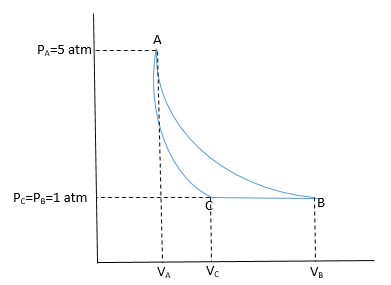College Physics
11th Edition
ISBN:9781305952300
Author:Raymond A. Serway, Chris Vuille
Publisher:Raymond A. Serway, Chris Vuille
Chapter1: Units, Trigonometry. And Vectors
Section: Chapter Questions
Problem 1CQ: Estimate the order of magnitude of the length, in meters, of each of the following; (a) a mouse, (b)...
Related questions
Question

Transcribed Image Text:2 moles of a diatomic ideal gas undergo
the following cyclic process, consisting
of an isothermal, isobaric, and an
adiabatic process. Given PA
5 atm,Pg = Pc = 1 atm and VA = 2lt.
%3D
%3D
a) Calculate the Volumes VB and Vc.
b) Calculate the work WAB, WBc,WCA
c) Calculate the Heat QAB, QBC, QCA•
pMm)
Expert Solution
Step 1
From the given conditions, the cyclic process would be graphically represented as below-

Step 2
Here,
AB is isothermal
BC is isobaric
CA is adiabatic
Also, for a diatomic gas,
(a)
Since AB is isothermal. So from ideal gas equation-
Now, from the adiabatic process CA-
(b)
Work done in the isothermal process in going from A to B is-
Work done during the isobaric process in going from B to C is-
Work done during the adiabatic process in going from C to A is-
(c)
In an isothermal process, change in internal energy is zero. Therefore-
In an isobaric process-
In an adiabatic process
Step by step
Solved in 3 steps with 1 images

Knowledge Booster
Learn more about
Need a deep-dive on the concept behind this application? Look no further. Learn more about this topic, physics and related others by exploring similar questions and additional content below.Recommended textbooks for you

College Physics
Physics
ISBN:
9781305952300
Author:
Raymond A. Serway, Chris Vuille
Publisher:
Cengage Learning

University Physics (14th Edition)
Physics
ISBN:
9780133969290
Author:
Hugh D. Young, Roger A. Freedman
Publisher:
PEARSON

Introduction To Quantum Mechanics
Physics
ISBN:
9781107189638
Author:
Griffiths, David J., Schroeter, Darrell F.
Publisher:
Cambridge University Press

College Physics
Physics
ISBN:
9781305952300
Author:
Raymond A. Serway, Chris Vuille
Publisher:
Cengage Learning

University Physics (14th Edition)
Physics
ISBN:
9780133969290
Author:
Hugh D. Young, Roger A. Freedman
Publisher:
PEARSON

Introduction To Quantum Mechanics
Physics
ISBN:
9781107189638
Author:
Griffiths, David J., Schroeter, Darrell F.
Publisher:
Cambridge University Press

Physics for Scientists and Engineers
Physics
ISBN:
9781337553278
Author:
Raymond A. Serway, John W. Jewett
Publisher:
Cengage Learning

Lecture- Tutorials for Introductory Astronomy
Physics
ISBN:
9780321820464
Author:
Edward E. Prather, Tim P. Slater, Jeff P. Adams, Gina Brissenden
Publisher:
Addison-Wesley

College Physics: A Strategic Approach (4th Editio…
Physics
ISBN:
9780134609034
Author:
Randall D. Knight (Professor Emeritus), Brian Jones, Stuart Field
Publisher:
PEARSON